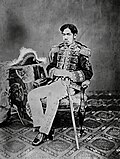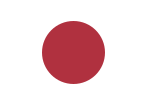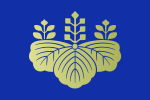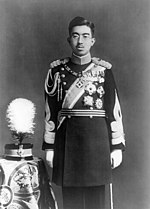 | after World War II. The current Japanese constitution was promulgated as an amendment of the Meiji Constitution of 1890 on 3 November 1946 when it came... 59 KB (7,135 words) - 04:50, 19 April 2024 |
 | The Meiji era (明治時代, Meiji jidai, [meꜜː(d)ʑi] ) was an era of Japanese history that extended from October 23, 1868, to July 30, 1912. The Meiji era was... 65 KB (8,013 words) - 23:35, 2 April 2024 |
 | Emperor of Japan (section Meiji Restoration (1868)) After the Meiji Restoration in 1868, the emperor was the embodiment of all sovereign power in the realm, as enshrined in the Meiji Constitution of 1889... 82 KB (9,720 words) - 11:54, 25 April 2024 |
of Meiji Japan (明治政府, Meiji seifu) was the government that was formed by politicians of the Satsuma Domain and Chōshū Domain in the 1860s. The Meiji government... 22 KB (3,102 words) - 05:39, 14 April 2024 |
1912 Meiji era, the name given to that period in Japanese history Meiji Restoration, the revolution that began the Meiji period Meiji Constitution, the... 1 KB (204 words) - 01:17, 9 November 2023 |
 | Kokutai (section Meiji Constitution) the Meiji Restoration. Each was a seitai, a form of government. In this understanding, the modern system of government under the Meiji Constitution, derived... 28 KB (3,745 words) - 13:13, 12 March 2024 |
 | The Meiji Restoration (Japanese: 明治維新, romanized: Meiji Ishin), referred to at the time as the Honorable Restoration (御一新, Goisshin), and also known as... 34 KB (4,043 words) - 05:25, 21 April 2024 |
 | 3 November 1852 – 30 July 1912), posthumously honored as Emperor Meiji (明治天皇, Meiji-tennō), was the 122nd emperor of Japan, according to the traditional... 61 KB (6,051 words) - 16:05, 23 April 2024 |
 | Meiji Shrine (明治神宮, Meiji Jingū) is a Shinto shrine in Shibuya, Tokyo, that is dedicated to the deified spirits of Emperor Meiji and his wife, Empress... 14 KB (1,122 words) - 07:44, 10 March 2024 |
Daijō Tennō (section Meiji constitution on abdication) Emperor Meiji wished to allow a clause codifying the right to abdicate and the formal institution of Daijō Tennō in the new Meiji Constitution. The Prime... 19 KB (831 words) - 01:20, 22 September 2023 |
 | government continued to formally operate under the provisions of the Meiji Constitution. Furthermore, at General MacArthur's insistence, Emperor Hirohito... 81 KB (8,877 words) - 21:01, 25 April 2024 |
 | Home Ministry (section Under the Meiji Constitution) (内務省, Naimu-shō) was a Cabinet-level ministry established under the Meiji Constitution that managed the internal affairs of Empire of Japan from 1873 to... 20 KB (1,350 words) - 13:47, 20 January 2024 |
 | Empire of Japan (section Meiji era (1868–1912)) Japanese nation-state that existed from the Meiji Restoration in 1868 until the enactment of the reformed Constitution of Japan in 1947. From 29 August 1910... 137 KB (15,187 words) - 02:57, 21 April 2024 |
Secular Shrine Theory (section Meiji Constitution) — Peter L. Berger, Holy Canopy: Sociology of the Holy World The Meiji Constitution said that subjects will have freedom of religion as long as it does... 33 KB (4,361 words) - 06:03, 2 March 2024 |
 | Teikoku) by the Meiji Constitution, it was not reminted at the establishment of the Meiji Constitution. Under the Meiji Constitution, the cases where... 6 KB (538 words) - 20:05, 20 October 2023 |
 | office in 1885, until the present day. 32 prime ministers under the Meiji Constitution had a mandate from the Emperor. The "electoral mandates" shown are... 97 KB (2,674 words) - 10:05, 23 April 2024 |
appeared in Japan after the Meiji Restoration, and gradually increased in importance after the promulgation of the Meiji Constitution and the creation of the... 13 KB (1,747 words) - 05:30, 23 October 2022 |
 | Japanese clothing during the Meiji period (1867–1912) saw a marked change from the preceding Edo period (1603–1867), following the final years of the... 46 KB (5,946 words) - 03:59, 8 April 2024 |
 | Japanese nationalism (redirect from Japanese nationalist thinking in the Meiji era) starting the Meiji Restoration. The Meiji Constitution of 1889 defined allegiance to the State as the citizen's highest duty. While the constitution itself... 48 KB (5,956 words) - 10:41, 6 April 2024 |










